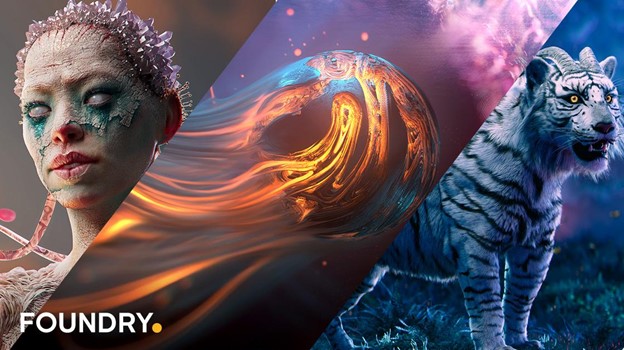Starting in October, Foundry began the rollout of new iterations of its flagship offerings, starting with Nuke, followed by Katana, and now Mari, with each getting a turn of the versioning number dial and will start anew with subsequent future point updates. Nuke moved to 15.0, while Katana and Mari both are now in 7.0; all include USD 23.05 and VFX Reference Platform 2023 support. Nuke and Katana have dual releases (14.1 and 6.5, respectively) to accommodate users with an OS migration plan, so they do not lose out on any of the functionality in the new versions, with the only major difference being the VFX RP being used.
What do we think? Foundry has been showing a commitment to USD since Nuke 12.2 in mid-2020. Since then, the company has been expanding support for the open standard. Obviously, the company had correctly read the tea leaves, as the M&E industry, as well as others, have been embracing USD in an effort to reduce silos and enable everyone to work and play together as productively and compatibly as possible. Foundry is a general member of the Alliance for OpenUSD, which is dedicated to fostering the standardization, development, evolution, and growth of OpenUSD.

Mari 7.0 now available, following the recent new releases of Nuke and Katana
Starting this past October, Foundry began its coordinated releases of major new versions to its flagship software offerings (Nuke, Katana, and Mari). These new versions support USD 23.05 and VFX Reference Platform 2023, as well as improved machine learning capabilities. Foundry said it is testing its releases on Rocky 9.1 and on matching versions of Alma and RHEL.
Uniquely, the company is providing dual releases of two of those products, Nuke and Katana—one with the new version number and the other an updated dot release—both of which offer mostly the same feature sets, with the major difference being the VFX Reference Platform (RP) support. The dual versions make it easier for studios planning an OS migration to make the transition, enabling them to use the latest performance and workflow enhancements while testing their pipelines against the latest Linux releases.
“With the dual release, users can upgrade to Nuke 14.1 to finish existing projects on CentOS 7, while still benefiting from the latest performance upgrades and workflow-enhancing features available in Nuke 15.0. When your studio is ready to make the jump to Rocky 9, Nuke 15.0 includes full support for VFX RP 2023 to make your pipeline transition easier,” Foundry states.
With the latest versions of these tools, Foundry is focusing on performance acceleration, expanded possibilities in machine learning, and new baking and texturing capabilities in Mari, stated Phil Parsonage, Foundry CTO.
Nuke 15.0 (and 14.1)
First up in the rollout was Nuke 15.0 (along with Nuke 14.1), with updates focused on speed, so artists can iterate faster. With native Apple silicon support across the family of Nuke tools (Nuke, NukeX, Nuke Studio, Hiero, HieroPlayer, and Nuke Indie), users can achieve faster general processing speeds of up to 20% and faster training speeds with Nuke’s CopyCat GPU-enabled machine learning tool by up to 2×, according to Foundry. CopyCat’s new distributed training shares the burden across multiple machines using standard render farm applications, enabling artists to run CopyCat in the background. With multi-resolution training, users are also able to compress image resolutions to reduce the size of the files during the early stages of the process.
Nuke 15.0 features USD-based 3D improvements (beta) including an all-new viewer selection with a dedicated 3D toolbar to quickly switch between object, face, or vertex mode, in addition to new two-tier selection capability. Other major changes include the ability to apply multi-pixel Blink effects such as LensDistortion and Denoise in the timeline (in Nuke Studio and Hiero only) without having to switch back and forth between the timeline and comp environments. OpenColorIO (OCIO) version 2.2 is supported for maintaining color consistency across the pipeline. Additionally, an update to GeoMerge gives users more control over managing layers when merging geometry and USD layers.
Katana 7.0 (and 6.5)
Foundry then kicked off November by releasing Katana 7.0 of its lookdev and lighting tool. It, too, follows in the footsteps of Nuke 15.0 (and 14.1) with a dual release (Katana 7.0 and Katana 6.5). Likewise, this dual release is identical in terms of features except when it comes to the VFX RP support.
This new release of Katana also features USD updates, building on the same underlying architecture as Nuke’s new 3D system (USD 23.05), which makes it easier to switch between applications. These updates include the framework for native USD manipulation in Katana, as well as various new nodes for using USD with Katana.
Katana 7.0 now sports multi-threaded Live Rendering and is compatible with Foresight+ for an improved user experience and better performance. Foundry says Live Render updates are up to 2× faster as a result of various performance improvements. And, the Geolib3-MT Runtime has been optimized with new caching strategies and better memory management to help minimize downtime.
Mari 7.0
As December rolled in, Foundry rolled out the final update for the year, as Mari, its 3D painting and texturing tool, was bumped up to version 7.0. Like the other two offerings in new release, Mari 7.0 also feature VFX RP 2023 and USD 23.05 support.
Mari 7.0 boasts new baking tools for quickly and easily creating geometry-based maps such as curvatures and occlusions, without requiring a separate application or plug-in. The new release also enables upgraded USD workflows, along with a more artist-friendly USD importer. Other added features include new Python examples and more procedural nodes, as well as access to 60 more grunge maps; automatic project backup access (locally or on a network) thanks to regular autosaving; and shader updates to Chaos’s V-Ray 6 and Autodesk’s Arnold Standard Surface so what is shown in Mari is the same as in the final render. And, team licensing is now available for Mari.